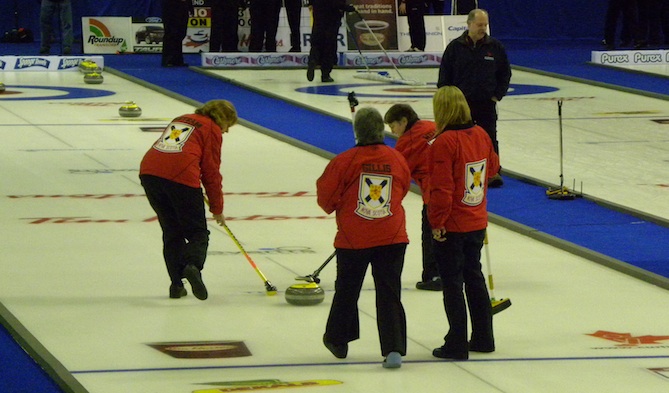House Call: Visually Impaired Curling
In recent years curling has been touted as a life sport. It can be played by children, adults and seniors, and there are very few stages of life when the sport is not an option. But aside from being a life sport, curling is also easily accessible to those with disabilities, including the visually impaired.
 Louise Gillis, of Sydney, Nova Scotia, threw her first curling stone in 1974 and she was hooked. Thirty-seven years later she’s still on the ice but, for her, the game has changed. Gillis is now visually impaired and the president of the Canadian Council of the Blind. Her team is made up of four visually impaired curlers, all with different levels of sight.
“You really do listen a lot more. You can tell how fast (the stone) is going by how it sounds,” explains Gillis about how the game changes for the visually impaired.
A visually impaired curling team is made up of a coach, a guide, and four curlers. The guide is actually on the ice with the curlers, sometimes holding a lighted broom anywhere from just in front of the thrower near the close tee-line to just near the hog-line. The guide lines their broom up with the skip’s broom at the other end so the thrower can tell where to aim. Depending on the amount of sight the thrower has, the guide may also line up the player’s body.
“A lot of visually impaired people have a fear of walking on the ice,” explains Gillis about barriers to the sport. However, according to Gillis, visually impaired curlers are actually less likely to fall because they use more caution on the ice.
Bill Mohrmann-Watson, President of the Ontario Blind Curlers Association, who has been curling for 20 years and currently plays with a vision impairment, says for those who don’t wish to use a slider or get down in the hack, the curling stick is a great option and has kept many individuals in the game.
“You might think you have to stop (playing because of a visual impairment), but you really don’t,” says Mohrmann-Watson with apparent enthusiasm for the game.
Terry Pipkey, a visually impaired curler from Prince George, B.C. thinks it’s great that there are opportunities for the blind to take part in the sport of curling. Each year he and his team vie for a spot at the Canadian Vision Impaired Curling Championship held in Ottawa.
“I’d like to see it become an international sport,” says Pipkey, going on to explain that with enough exposure it could become part of the disabled games which normally take place pre or post Olympics. Visually impaired curling needs to become more popular across the pond for this to happen.
Individuals looking to get involved with visually impaired curling should contact their provincial branch of the Canadian Council of the Blind or speak to their provincial curling organization.
Louise Gillis, of Sydney, Nova Scotia, threw her first curling stone in 1974 and she was hooked. Thirty-seven years later she’s still on the ice but, for her, the game has changed. Gillis is now visually impaired and the president of the Canadian Council of the Blind. Her team is made up of four visually impaired curlers, all with different levels of sight.
“You really do listen a lot more. You can tell how fast (the stone) is going by how it sounds,” explains Gillis about how the game changes for the visually impaired.
A visually impaired curling team is made up of a coach, a guide, and four curlers. The guide is actually on the ice with the curlers, sometimes holding a lighted broom anywhere from just in front of the thrower near the close tee-line to just near the hog-line. The guide lines their broom up with the skip’s broom at the other end so the thrower can tell where to aim. Depending on the amount of sight the thrower has, the guide may also line up the player’s body.
“A lot of visually impaired people have a fear of walking on the ice,” explains Gillis about barriers to the sport. However, according to Gillis, visually impaired curlers are actually less likely to fall because they use more caution on the ice.
Bill Mohrmann-Watson, President of the Ontario Blind Curlers Association, who has been curling for 20 years and currently plays with a vision impairment, says for those who don’t wish to use a slider or get down in the hack, the curling stick is a great option and has kept many individuals in the game.
“You might think you have to stop (playing because of a visual impairment), but you really don’t,” says Mohrmann-Watson with apparent enthusiasm for the game.
Terry Pipkey, a visually impaired curler from Prince George, B.C. thinks it’s great that there are opportunities for the blind to take part in the sport of curling. Each year he and his team vie for a spot at the Canadian Vision Impaired Curling Championship held in Ottawa.
“I’d like to see it become an international sport,” says Pipkey, going on to explain that with enough exposure it could become part of the disabled games which normally take place pre or post Olympics. Visually impaired curling needs to become more popular across the pond for this to happen.
Individuals looking to get involved with visually impaired curling should contact their provincial branch of the Canadian Council of the Blind or speak to their provincial curling organization.

Visually impaired curler Louise Gillis follows her rock down the ice with her guide beside her (Photo courtesy L. Gillis)




